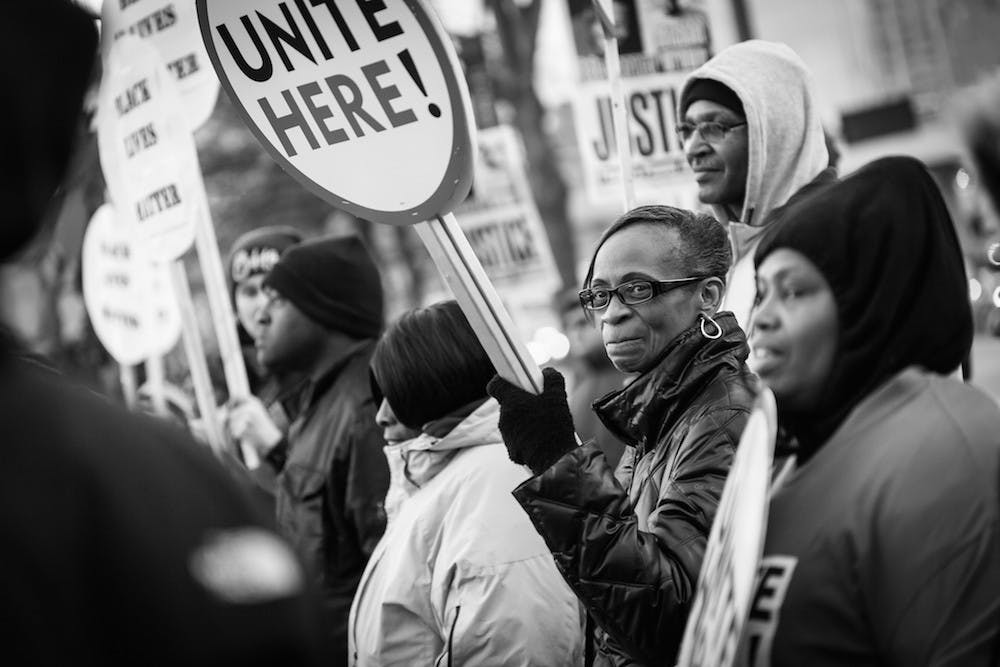With the “Black Lives Matter” movement becoming increasingly prevalent in our political discourse, procedural due process and racial inequity are being discussed more readily. The cascade of eyebrow raising events that precipitated the movement (i.e. the deaths of Sandra Bland, Walter Scott, Eric Garner, and of course Michael Brown) has called into question what specifically constitutes a justifiable use of force. However, there is an issue that has largely been glossed over and seems to teem with racial disparity– the death penalty.
This summer I stumbled across a terse yet poignant book about what this pertinent issue. Capital Punishment on Trial, by David M. Oshinsky, details the history of the death penalty in the United States in an engrossing and incisive manner. One of its most compelling and relevant sections to the “Black Lives Matter” Movement recounts two court cases– Maxwell v. Bishop and McCleskey v. Kemp. To clarify the relevant jurisprudential history,the petitioners, represented by the NAACP’s Legal Defense Fund, did not assert that the death penalty constituted a “cruel and unusual punishment.” Instead the case sought the penalty’s abolition on Equal Protection grounds.
On the surface this may seem to be a tenuous argument; however, the statistics at that time gave the claim credibility. The first case, Maxwell v. Bishop, featured a 22 year-old African-American defendant who faced death in Arkansas for raping a white woman. The leading lawyer in this case, Tony Amsterdam, appealed this case through the federal court system. To buttress his case, Amsterdam reached out to University of Pennsylvania criminologist, Marvin Wolfgang, to study the discriminatory imposition of the death penalty.
The results were not only compelling, but also counterintuitive. An “Equal Protection” argument in a racial context would probably make its listener think that its claimant is implying that capital punishment is a legalized form of euthanasia inflicted gratuitously upon people of color regardless of the severity of the crime. Instead, the claim was that capital punishment was imposed far more frequently when a black defendant victimizes a white person. In fact, Wolfgang’s findings, showed that, in Arkansas specifically, black defendants who victimized a white person were 3.4 times more likely to be sentenced to death compared to cases of a black victim and a white perpetrator. The raping of a Caucasian, statistically, is more egregious and more deserving of the harshest penalty possible than the raping of an African-American. In the context of the imposition of the death penalty, black lives don’t necessarily matter.
Despite this evidence, the Court of Appeals roundly rejected the argument. Then-Judge and soon-to-be Supreme Court Justice Harry Blackmunwrote the majority opinion. “Although the investigation and study made by Professor Wolfgang in the summer of 1965 is interesting and provocative,” Blackmun wrote, “we do not, on the basis of that study, upset Maxwell’s conviction and, as a necessary consequence, cast serious doubt on every other rape conviction in the state courts of Arkansas.”
However, this particular argument against the death penalty did not fade. McCleskey v. Kemp was a case in which an African-American was tried and sentenced to death for the killing of a police officer during the commission of a robbery in Georgia. McCleskey’s appellate attorney, Jack Boger from the Legal Defense fund, sought empirical research from David Baldus, a law professor from the University of Iowa. Bladus’s findings corroborated Professor Wolfgang’s study. The data revealed that jurors were 11 times more likely to assess Georgia’s death penalty in instances in which there was a white victim juxtaposed to a black one. The Supreme Court, however, rejected the argument, even as Justice Blackmun, who had previously authored the Maxwell opinion, effectively reversed his previous thinking and dissented in McCleskey. Justice Lewis F. Powell wrote in the majority opinion, “we hold that the Baldus study is clearly insufficient to support an inference that any of the decisionmakers [sic] in McCleskey’s case acted with discriminatory purpose.”
Today, there is still a substantial racial disparity in death penalty cases. According to the Death Penalty Information Center, 75% of the people who were victims of capital crimes were white and only 15% were black. What’s more, while African-Americans only comprise 12-13% of the population, they currently comprise 41.7% of death row inmates. This begs the question that is implicitly posed by the very title of this article; should “Black Lives Matter” at least mention this? If so, what should be its stance? While the answer to the first question might seem a bit more obvious now, a response to the second one is not so facile.
If the movement were to adopt the viewpoint of Harvard Law School professor and former clerk to Justice Thurgood Marshall, Randall Kennedy, the answer would be essentially expanding the capital punishment. This would mean emphasizing more equal imposition of the death penalty across all capital cases, irrespective of race. However, the crime for which the death penalty is most often levied is murder. Since most murder victims are killed by members of the victim’s own race, such a “reform” would probably just enlarge the amount of African-Americans who are executed.
The other stance would be abolition, and the trend of the country seems to be heading in that direction. There have been obvious court victories, included the ban against imposing the death penalty in cases of the non-lethal crime of rape (Coker v. Georgia) and restricting its imposition to persons 18 and older (Roper v. Simmons). Also, while a majority of Americans believe that there should be a death penalty, the sentence of death is being rendered less often. Since a post-Gregg peak of 98 executions in 2000, the number of executions per year has generally decreased. In 2014, only 35 people were actually put to death. Nineteen states and the District of Columbia have banned the death penalty, and a third of them have done so in just the past eight years. In the talk about criminal justice reform, “Black Lives Matter” should elucidate this issue and discuss its propensity to be arbitrary and racially biased; it would be an negligent and disingenuous not to. To paraphrase the infamous words of Justice Blackmun, perhaps we, as a country, should no longer “tinker with the machinery of death.”
Contact Jabari A. Lucas at jabari.lucas@richmond.edu.
Enjoy what you're reading?
Signup for our newsletter
Support independent student media
You can make a tax-deductible donation by clicking the button below, which takes you to our secure PayPal account. The page is set up to receive contributions in whatever amount you designate. We look forward to using the money we raise to further our mission of providing honest and accurate information to students, faculty, staff, alumni and others in the general public.
Donate Now



